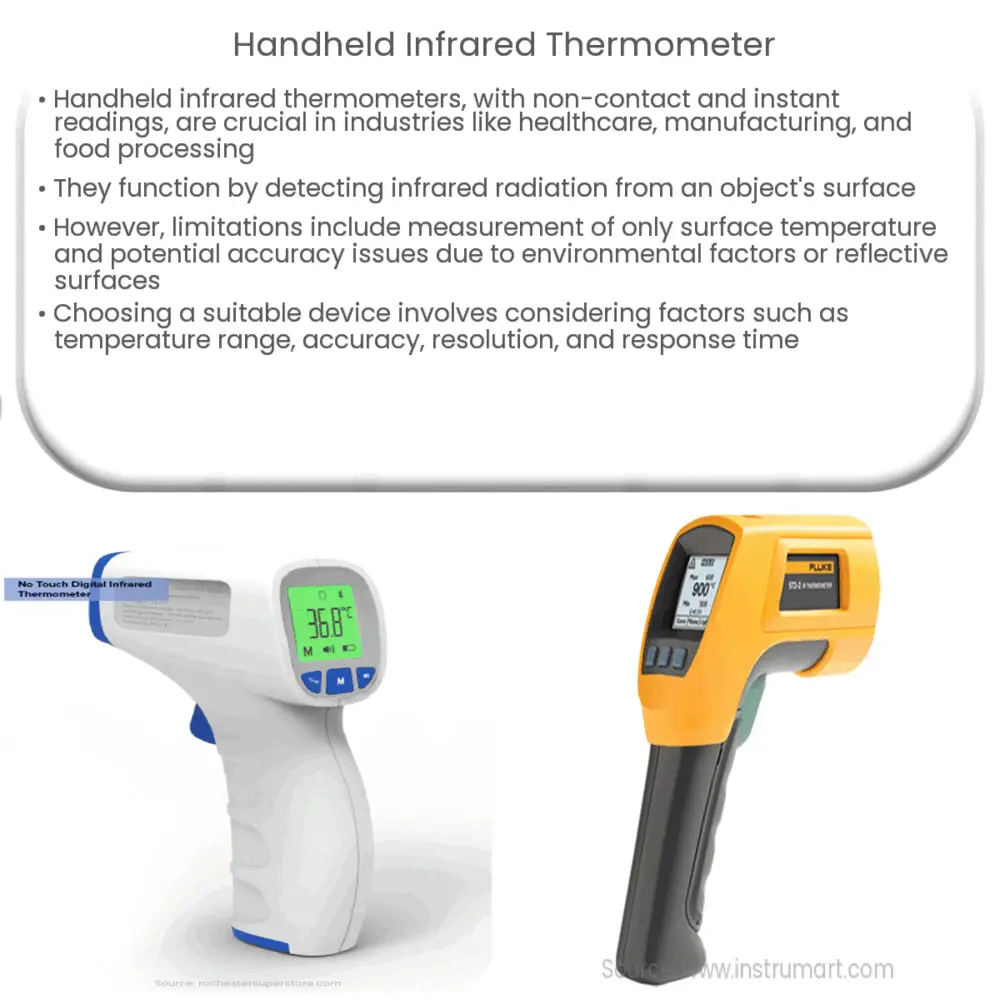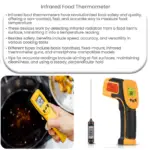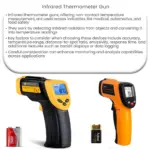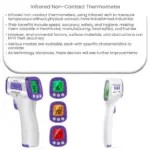Handheld infrared thermometers enable non-contact, fast, and safe temperature measurements for various industries and applications.

Handheld Infrared Thermometers: A Comprehensive Overview
Introduction
In today’s fast-paced world, accurate and efficient temperature measurement is crucial in various industries, including healthcare, manufacturing, and food processing. Handheld infrared thermometers have become increasingly popular due to their non-contact nature, ease of use, and rapid results. In this article, we will explore the principles behind infrared thermometers, their various applications, advantages, and potential limitations.
How Do Handheld Infrared Thermometers Work?
Handheld infrared thermometers, also known as non-contact thermometers or temperature guns, use infrared technology to measure the temperature of an object’s surface. This is done by detecting the infrared radiation emitted by the object and converting it into a temperature value. The main components of a handheld infrared thermometer include an infrared sensor, a lens, a display, and a processing unit.
The infrared sensor detects the radiation coming from the object’s surface and converts it into an electrical signal. The lens focuses the infrared radiation onto the sensor, ensuring accurate readings. The processing unit then processes the electrical signal to calculate the temperature and displays it on the device’s screen.
Applications of Handheld Infrared Thermometers
Handheld infrared thermometers have a wide range of applications across various industries. Some of the most common uses include:
- Healthcare: Infrared thermometers are widely used in hospitals and clinics for quick and non-invasive body temperature measurements. They are particularly useful during pandemics, as they minimize contact between patients and healthcare providers.
- Industrial Manufacturing: In manufacturing plants, handheld infrared thermometers can help monitor and maintain the optimal temperature of machinery and equipment, preventing overheating and ensuring safety and efficiency.
- Food Processing: Food safety is of utmost importance in the food industry, and temperature monitoring plays a critical role in ensuring food quality. Infrared thermometers can quickly measure the temperature of raw materials, cooking surfaces, and finished products without physical contact, minimizing contamination risks.
- Automotive: Mechanics and automotive technicians often use handheld infrared thermometers to diagnose and troubleshoot engine issues by measuring the temperature of various engine components.
Advantages of Handheld Infrared Thermometers
Handheld infrared thermometers offer several advantages over traditional contact-based thermometers:
- Non-contact: The ability to measure temperature without physical contact reduces the risk of contamination and damage to the object being measured. This is particularly useful in healthcare settings, where minimizing the spread of infections is crucial.
- Speed: Infrared thermometers provide instant temperature readings, making them ideal for situations where rapid results are necessary.
- Safety: These devices allow users to measure the temperature of hazardous or hard-to-reach objects from a safe distance, reducing the risk of injury.
- Versatility: Handheld infrared thermometers can be used on a wide range of materials and surfaces, making them suitable for various industries and applications.
Potential Limitations of Handheld Infrared Thermometers
Despite their numerous advantages, handheld infrared thermometers have some limitations that users should be aware of:
- Surface Temperature Only: Infrared thermometers measure the surface temperature of an object, which might not always represent the internal temperature, especially in cases of liquids and semi-solids.
- Accuracy: The accuracy of infrared thermometers can be affected by various factors such as the emissivity of the object’s surface, environmental conditions, and the distance-to-spot ratio of the device.
- Interference: Infrared thermometers may provide inaccurate readings in the presence of dust, smoke, or steam, as these particles can interfere with the infrared radiation emitted by the object.
- Reflective Surfaces: Measuring the temperature of reflective surfaces, such as polished metal, can be challenging due to the reflection of infrared radiation from surrounding objects.
Choosing the Right Handheld Infrared Thermometer
With various models and specifications available in the market, selecting the right handheld infrared thermometer can be daunting. Here are some key factors to consider when choosing an infrared thermometer:
- Temperature Range: Ensure that the thermometer covers the temperature range required for your specific application.
- Accuracy and Resolution: Choose a device with high accuracy and resolution to ensure precise temperature readings.
- Distance-to-Spot Ratio (D:S): A higher D:S ratio allows for temperature measurements from a greater distance without compromising accuracy. This is especially useful when measuring the temperature of hazardous or hard-to-reach objects.
- Emissivity: Select a thermometer with adjustable emissivity settings to accurately measure the temperature of different materials and surfaces.
- Response Time: Opt for a thermometer with a fast response time to obtain rapid temperature readings.
Conclusion
Handheld infrared thermometers have revolutionized temperature measurement in various industries, offering non-contact, fast, and safe temperature readings. By understanding their working principles, applications, advantages, and limitations, users can make informed decisions when selecting the right infrared thermometer for their specific needs. Proper use and maintenance of these devices are crucial to ensure accurate and reliable temperature measurements, ultimately contributing to improved safety and efficiency in various applications.




